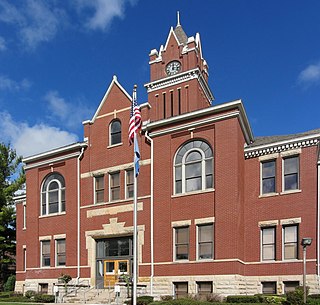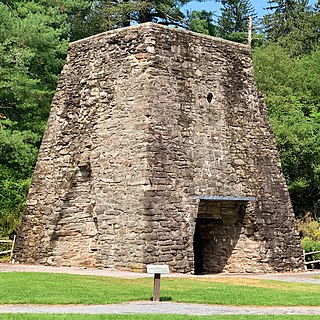The Antrim Iron Company was an iron works that operated in Mancelona, Michigan from 1886 to 1945. The site of the iron works was south of Mancelona, between U.S. Route 131 and the railroad tracks.
The Antrim Iron Company was an iron works that operated in Mancelona, Michigan from 1886 to 1945. The site of the iron works was south of Mancelona, between U.S. Route 131 and the railroad tracks.
In 1882, an organization by the name of "John Otis & Company" built a large charcoal furnace on the site. The company also platted a town around the furnace, naming it "Furnaceville". Soon after this, the Grand Rapids and Indiana Railroad built a station at the town. The furnace flourished, and in 1886 a group of businessmen from Grand Rapids bought out the company, and renamed the company Antrim Iron Works and the town Antrim. A large blast furnace and iron works was built on the site, and the new company began doing business.
In the beginning of the corporation, timber was hauled in from various lumber camps around Northern Michigan to be harvested for iron products at the plant. After many years of buying material to create the iron with, the company decided to obtain its own timber, and built a small railroad branch (named the Mancelona North West Railroad) heading 2 miles west from the company site. With this spur line, the company logged its own lumber and hauled it in on its own railroad, proving to be quite self-sufficient. This lasted until the 1920s, when the lumber ran out and other ways were developed to obtain the iron.
During World War II the company became extremely busy. With the vast need for materials for the war effort, the factory was working around the clock trying to produce enough products for the orders they were getting. This held true throughout most of the war.
After the war ended, the company quickly slowed down, and closed in 1945. The factory stood abandoned for over forty years, until it was torn down in the mid-1980s. Today all that is left of the old furnace consists of a few foundations, a small outbuilding, and a former railroad siding. The company dumped its waste in a pond behind the building, which years later led to water contamination in the town. The pond, called "Tar Lake", was cleaned up in the mid to late 1990s.

Antrim County is a county located in the U.S. state of Michigan. As of the 2010 census, the population was 23,580. The county seat is Bellaire. The name is taken from County Antrim in Northern Ireland.

Mancelona Township is a civil township of Antrim County in the U.S. state of Michigan. The population was 4,400 at the 2010 census.
The Grand Rapids and Indiana Railroad at its height provided passenger and freight railroad services between Cincinnati, Ohio, and the Straits of Mackinac in Michigan, USA. The company was formed on January 18, 1854.
The Boyne City Railroad was a railway based at Boyne City, Michigan, U.S., during 1893–1978.
Shenandoah Valley Railroad was a line completed on June 19, 1882, extending down the Shenandoah Valley from Hagerstown, Maryland through the West Virginia panhandle into Virginia to reach Roanoke, Virginia and to connect with the Norfolk and Western Railway (N&W). The development of this railroad had considerable backing from the Pennsylvania Railroad. In September 1890 it went into bankruptcy and was reorganized as the Shenandoah Valley Railway. In December 1890, it became part of N&W. Today the tracks are a major artery of the Norfolk Southern system.
The Bellefonte Central Railroad was a shortline connecting Bellefonte and State College, Pennsylvania. Constructed in the late 19th century to haul local iron ore to furnaces in the Bellefonte region, it later hauled freight traffic to Penn State and lime for steelmaking from local quarries. The line to State College was abandoned in 1974, and most of the remaining railroad in 1984, but a small portion is still used by the Nittany and Bald Eagle Railroad.

Tahawus was a village in the Town of Newcomb, Essex County, New York, United States. It is now a ghost town situated in the Adirondack Park. Tahawus is located in Essex County within the unpopulated northern area designated to the town of Newcomb. Tahawus was the site of major mining and iron smelting operations in the 19th century. Although standing as recently as 2005, the last mining facilities have since been demolished and removed.
The Mont Alto Rail Road was a railroad in Franklin County, Pennsylvania, originally built to connect the blast furnaces of the Mont Alto Iron Company to the Cumberland Valley Railroad. It was later extended south to reach Waynesboro.
Graysdale is an unincorporated community in Patton Township, Centre County, Pennsylvania, located at 40.8130°N 77.9548°W.

Nittany Furnace, known earlier as Valentine Furnace, was a hot blast iron furnace located in Spring Township, Centre County, Pennsylvania, United States. Placed in operation in 1888 on the site of an older furnace, it was an important feature of Bellefonte economic life until it closed in 1911, no longer able to compete with more modern steel producers.

The Iron Range & Huron Bay Railroad (IR&HB) is a defunct railroad constructed to haul iron ore in Michigan's Upper Peninsula during the 1890s. Financial and engineering problems prevented the railroad's operation; it remains an unusual example of a railroad which was completed but never used.

Eber Brock Ward was an American industrialist, iron and steel manufacturer, and shipbuilder. He was known as the "steamship king of the Great Lakes" and the "first of the iron kings." Ward became Detroit's first millionaire. His steel factories made him the wealthiest man in the Midwest, in his time.

Pino Grande is an unincorporated community in El Dorado County, California. It is located 8 miles (13 km) north-northwest of Pollock Pines, at an elevation of 4022 feet.
The East Jordan and Southern Railroad was a shortline railroad that operated from 1901 to 1962 between East Jordan and Bellaire, Michigan.

EJ is a company based in East Jordan, Michigan. The company is a manufacturer and distributor of iron construction castings and infrastructure access products worldwide. In 2007, the company was awarded the National Utility Contractors Association Associate of the year award.

Justus Smith Stearns was an American lumber baron and businessman. He was involved in many enterprises that involved commercial real estate development, sawmills, coal, farming, railroading, and electrical technology. He started his lumber pursuits as a teenager at his father's sawmills. From the business knowledge he learned from his father he became a lumber merchant in his twenties.

The Pine Grove Iron Works was a southcentral Pennsylvania smelting facility during the Industrial Revolution. The works is notable for remaining structures that are historical visitor attractions of Pine Grove Furnace State Park, including the furnace stack of the Pine Grove Furnace. The site was listed on the National Register of Historical Places on April 13, 1977 for its significance in architecture and industry. It includes seven contributing buildings, two structures, fourteen sites, and two objects.

March Rapids is an unincorporated community located in the town of Eau Pleine, Marathon County, Wisconsin, United States.
The Detroit and Charlevoix Railroad is a defunct railroad that was located in Northern Lower Michigan. It was created to haul finished lumber from timber lands to market. It was acquired by the Michigan Central Railroad.

The Missouri Lumber and Mining Company (MLM) was a large timber corporation with headquarters and primary operations in southeast Missouri. The company was formed by Pennsylvania lumbermen who were eager to exploit the untapped timber resources of the Missouri Ozarks to supply lumber, primarily used in construction, to meet the demand of U.S. westward expansion. Its primary operations were centered in Grandin, a company town it built starting c. 1888. The lumber mill there grew to be the largest in the country at the turn of the century and Grandin's population peaked around 2,500 to 3,000. As the timber resources were exhausted, the company had to abandon Grandin around 1910. It continued timber harvesting in other parts of Missouri for another decade. While some of the buildings in Grandin were relocated, many of the remaining buildings were listed on the National Register of Historic Places in 1980 as part of the state's historic preservation plan which considered the MLM a significant technological and economic contributor to Missouri.
Coordinates: 44°52′59.5″N85°04′30.7″W / 44.883194°N 85.075194°W